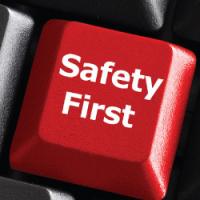- Posts: 350
- Thank you received: 11
Make a Mental Map
- Safety Toolbox Talk Webmaster
-
 Topic Author
Topic Author - Offline
- Administrator
-

When you're on an extended automobile trip, it's a good idea to keep a road map handy, especially if you're in strange territory. Occasionally you may also run across a diagram on the bulletin board or in a newspaper that holds your attention. In either case, the map or the diagram assists you in finding your way around or in obtaining some other kind of information.
Rarely do you see anyone walking around at work with a map. That's because each person has a mental map of where they must go to perform their job. But a mental map shouldn't stop at simple directions. For safety's sake, the mental map you make should carry several other important items, such as location of the first aid station, fire extinguishers and other emergency equipment. But, above all, it should carry a well defined picture of your job and the equipment you use. Here are a couple of actual cases that occurred in another part of the state which highlight the importance of mental alertness on the job:
The branch office of a bank was robbed and a sizeable amount of money was taken. The manager, in an exhibition of foolhardiness, pursued the hold-up man out the door. In the chase that followed, the manager fell down and fractured his knee. Actually, he was lucky not to have been shot.
No doubt the manager had been instructed as to how to react in a hold-up situation, and maybe he had even instructed other employees on the same subject. But when the emergency arose, he reacted contrary to good judgement, and although he escaped unharmed in the hold-up, he was injured in the action that followed.
Apparently he didn't have a mental map, or he got it confused with something he had seen on television. After the hold-up man left, the branch manager should have gone to the nearest telephone or alarm system. Pursuit of the hold-up man added an unsafe act to an already unsafe situation.
In another incident, a supervisor was explaining the function of a die to a die-setter. While pointing, and placing a finger on the die, the press accidentally cycled, amputating the finger.
In this instance, a mental lapse resulted in an accident. Needless to say, the mishap to the supervisor proved to be a very realistic explanation of the function of the die.
These incidents illustrate that alertness makes a mental map readable.
Here are some items that safety experts say should be included on your mental map, in addition to your own work area and equipment:
The closest first aid station and procedures for contacting the police and an ambulance. The closest fire extinguisher and fire alarm. It's obvious why these items head the list, although the other suggestions are not necessarily of less importance in their own right.
Other items are: where to turn in tools for repair, where tools, other than the ones you keep and use at your workplace, are kept.
The nearest water fountain, areas where you're most likely to encounter either hand or motorized trucks, areas where there may be danger from high working places or suspended loads.
The spot where you can usually find your supervisor, the nearest restroom, and the nearest exit.
You probably have got other things in mind that could be added to the list. For instance, if you worked with chemicals, you would certainly include the closest eye-wash fountain and emergency shower.
The important thing to know is where to go and how to get there the quickest and safest way.
People in pain or under stress may act unwisely. They may hurry around aggravating their problems and accomplishing nothing. This is where the good mental map comes in. It can help you to react to emergency situations in the safest way as well as to perform your regular job safely.
Please Log in or Create an account to join the conversation.
